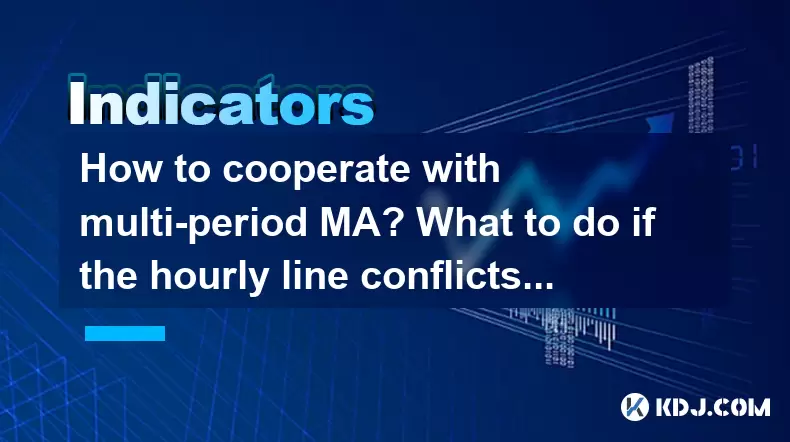-
 bitcoin
bitcoin $112195.049338 USD
2.42% -
 ethereum
ethereum $4124.915858 USD
2.81% -
 tether
tether $1.000570 USD
0.02% -
 xrp
xrp $2.861568 USD
2.25% -
 bnb
bnb $1000.346670 USD
3.04% -
 solana
solana $209.070819 USD
3.38% -
 usd-coin
usd-coin $0.999870 USD
0.02% -
 dogecoin
dogecoin $0.235379 USD
2.65% -
 tron
tron $0.335681 USD
-0.20% -
 cardano
cardano $0.803501 USD
3.38% -
 hyperliquid
hyperliquid $47.120881 USD
3.56% -
 chainlink
chainlink $21.501300 USD
3.44% -
 ethena-usde
ethena-usde $1.000571 USD
0.02% -
 avalanche
avalanche $29.793378 USD
3.62% -
 stellar
stellar $0.366964 USD
2.42%
How to cooperate with multi-period MA? What to do if the hourly line conflicts with the daily line?
Multi-period MAs help traders analyze trends across different time frames, enhancing decision-making by identifying both short-term and long-term market movements.
May 21, 2025 at 08:43 pm

Introduction to Multi-Period Moving Averages (MA)
Understanding Multi-Period Moving Averages is crucial for any trader looking to enhance their trading strategy. Moving Averages (MA) are a widely used technical indicator in the cryptocurrency trading world, helping traders identify trends over different time frames. When we talk about multi-period MAs, we refer to using more than one MA across different time frames to make more informed trading decisions. This approach can help traders gain a broader perspective on market trends, enabling them to make trades that align with both short-term and long-term market movements.
Setting Up Multi-Period MAs
To start using multi-period MAs effectively, you need to set up your trading platform correctly. Here’s how you can do it:
- Choose Your Time Frames: Decide on the time frames you want to analyze. Common choices include the hourly, daily, and weekly charts. For instance, you might choose to use a 50-day MA on the daily chart and a 20-hour MA on the hourly chart.
- Select Your MA Type: There are various types of MAs, such as Simple Moving Averages (SMA) and Exponential Moving Averages (EMA). For multi-period analysis, many traders prefer EMAs due to their responsiveness to recent price changes.
- Add MAs to Your Charts: On your trading platform, add the chosen MAs to the respective time frames. Ensure that the color coding is clear to differentiate between different MAs easily.
Interpreting Multi-Period MAs
Once your MAs are set up, the next step is to interpret the signals they provide. The key is to look for confluence between different time frames. If the hourly MA is trending upwards and the daily MA is also trending upwards, this indicates a strong bullish trend. Conversely, if the hourly MA is trending downwards while the daily MA is trending upwards, it might suggest a short-term bearish correction within a longer-term bullish trend.
Handling Conflicts Between Hourly and Daily MAs
Conflicts between the hourly and daily MAs are common and can be challenging to navigate. Here’s how you can approach such scenarios:
- Assess the Strength of Each Trend: Look at the slope and distance between the MAs on both time frames. A steeper slope on the daily MA might indicate a stronger long-term trend compared to the hourly MA.
- Consider the Price Action: Analyze the price action around the MAs. If the price is consistently respecting the daily MA but showing volatility around the hourly MA, it might suggest that the daily trend is more reliable.
- Use Additional Indicators: Incorporate other technical indicators like the Relative Strength Index (RSI) or the Moving Average Convergence Divergence (MACD) to get a more comprehensive view of the market.
Trading Strategies Based on Multi-Period MAs
Developing trading strategies using multi-period MAs involves a few key steps:
- Entry Points: Look for moments when the hourly MA crosses above the daily MA, signaling a potential bullish entry. Conversely, a bearish entry might be signaled when the hourly MA crosses below the daily MA.
- Exit Points: Use the daily MA as a guide for long-term exits. If the price moves below the daily MA after a bullish entry, it might be time to exit the trade.
- Risk Management: Always set stop-loss orders based on the volatility indicated by the hourly MA. This helps protect your investment from short-term market fluctuations.
Practical Example of Using Multi-Period MAs
Let’s walk through a practical example of how you might use multi-period MAs to make a trading decision:
- Scenario: You are analyzing Bitcoin on both the hourly and daily charts. The daily chart shows a 50-day EMA trending upwards, while the hourly chart shows a 20-hour EMA trending downwards.
- Analysis: The conflicting signals suggest a short-term bearish correction within a long-term bullish trend. You decide to wait for the hourly EMA to cross back above the daily EMA, indicating the end of the correction.
- Action: Once the hourly EMA crosses above the daily EMA, you enter a long position on Bitcoin, setting a stop-loss just below the recent low on the hourly chart.
- Monitoring: You keep an eye on the daily EMA, ready to exit the trade if the price falls below it, signaling a potential reversal in the long-term trend.
Frequently Asked Questions
Q: Can multi-period MAs be used for all cryptocurrencies?A: Yes, multi-period MAs can be applied to any cryptocurrency. However, the effectiveness might vary depending on the liquidity and volatility of the specific cryptocurrency. More liquid assets tend to provide clearer signals.
Q: How often should I check the multi-period MAs?A: The frequency depends on your trading style. Day traders might check hourly MAs multiple times a day, while swing traders might focus more on daily MAs and check them once or twice a day.
Q: Is it necessary to use both SMA and EMA for multi-period analysis?A: No, it is not necessary. Many traders find that using either SMA or EMA consistently across all time frames provides sufficient information. The choice between SMA and EMA depends on your preference for responsiveness to recent price changes.
Q: Can multi-period MAs be used in conjunction with other trading strategies?A: Absolutely. Multi-period MAs can complement other strategies such as trend following, mean reversion, or even fundamental analysis. They provide a framework for understanding market trends, which can enhance the effectiveness of other trading approaches.
Disclaimer:info@kdj.com
The information provided is not trading advice. kdj.com does not assume any responsibility for any investments made based on the information provided in this article. Cryptocurrencies are highly volatile and it is highly recommended that you invest with caution after thorough research!
If you believe that the content used on this website infringes your copyright, please contact us immediately (info@kdj.com) and we will delete it promptly.
- SWIFT, Consensys, and Blockchain Settlement: A New Era for Global Finance?
- 2025-09-30 06:25:13
- Gold Dollar Coin, Mystery, Upright 5: Unearthing Hidden History and Whale-Sized Speculation
- 2025-09-30 06:25:13
- Meme Coins, Smart Money, 2025 Riches: Navigating the Hype
- 2025-09-30 06:30:01
- VeChain (VET) Price Prediction 2026: Bullish Breakout or Enterprise Stalemate?
- 2025-09-30 06:30:01
- BetFi Coin: Is This the Next High-ROI Crypto Presale?
- 2025-09-30 06:30:01
- Bitcoin, Nvidia, and the Potential Upside: Lessons from the AI Boom
- 2025-09-30 06:30:15
Related knowledge

What is a tower bottom candlestick pattern? Does it have a high success rate?
Sep 22,2025 at 07:18am
Tower Bottom Candlestick Pattern Explained1. The tower bottom candlestick pattern is a reversal formation that typically appears at the end of a downt...

What is a black hole pattern in the MACD indicator? Is it a cause for concern?
Sep 21,2025 at 06:54pm
Bitcoin's Role in Decentralized Finance1. Bitcoin remains the cornerstone of decentralized finance, serving as a benchmark for value and security acro...

How can I use the psychological line (PSY) to determine market sentiment?
Sep 17,2025 at 02:19pm
Understanding the Psychological Line (PSY) in Cryptocurrency TradingThe Psychological Line, commonly referred to as PSY, is a momentum oscillator used...

How can I determine if a double top pattern has officially formed?
Sep 21,2025 at 03:18am
Understanding the Structure of a Double Top Pattern1. A double top pattern consists of two distinct peaks that reach approximately the same price leve...

What is the Golden Valley pattern on the moving average? Is it better than the Silver Valley pattern?
Sep 21,2025 at 02:54pm
Understanding the Golden Valley Pattern in Moving Averages1. The Golden Valley pattern is a technical formation observed in cryptocurrency price chart...

What does a death cross of the RSI in the strong zone (above 50) mean?
Sep 17,2025 at 10:54pm
Understanding the Death Cross in RSI Context1. The term 'death cross' is traditionally associated with moving averages, where a short-term average cro...

What is a tower bottom candlestick pattern? Does it have a high success rate?
Sep 22,2025 at 07:18am
Tower Bottom Candlestick Pattern Explained1. The tower bottom candlestick pattern is a reversal formation that typically appears at the end of a downt...

What is a black hole pattern in the MACD indicator? Is it a cause for concern?
Sep 21,2025 at 06:54pm
Bitcoin's Role in Decentralized Finance1. Bitcoin remains the cornerstone of decentralized finance, serving as a benchmark for value and security acro...

How can I use the psychological line (PSY) to determine market sentiment?
Sep 17,2025 at 02:19pm
Understanding the Psychological Line (PSY) in Cryptocurrency TradingThe Psychological Line, commonly referred to as PSY, is a momentum oscillator used...

How can I determine if a double top pattern has officially formed?
Sep 21,2025 at 03:18am
Understanding the Structure of a Double Top Pattern1. A double top pattern consists of two distinct peaks that reach approximately the same price leve...

What is the Golden Valley pattern on the moving average? Is it better than the Silver Valley pattern?
Sep 21,2025 at 02:54pm
Understanding the Golden Valley Pattern in Moving Averages1. The Golden Valley pattern is a technical formation observed in cryptocurrency price chart...

What does a death cross of the RSI in the strong zone (above 50) mean?
Sep 17,2025 at 10:54pm
Understanding the Death Cross in RSI Context1. The term 'death cross' is traditionally associated with moving averages, where a short-term average cro...
See all articles


























![[Pycoin] PI Coin -Shocking Listance of Pycoin?! 'Rebellion' This time ... Pay attention to #paikoin [Pycoin] PI Coin -Shocking Listance of Pycoin?! 'Rebellion' This time ... Pay attention to #paikoin](/uploads/2025/09/29/cryptocurrencies-news/videos/pycoin-pi-coin-shocking-listance-pycoin-rebellion-time-pay-attention-paikoin/68da82f23cec1_image_500_375.webp)















































